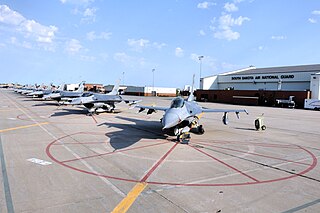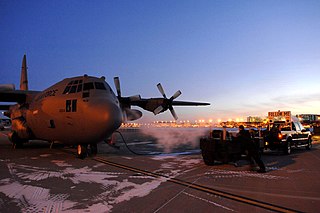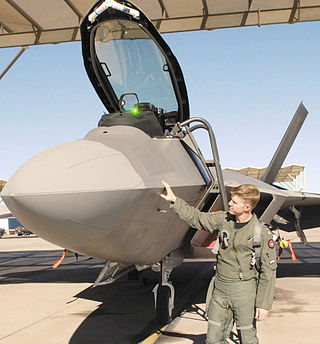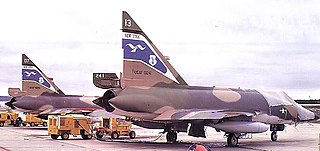
The 114th Fighter Wing is a unit of the South Dakota Air National Guard, stationed at Joe Foss Field Air National Guard Station, Sioux Falls Regional Airport, Sioux Falls, South Dakota. If activated to federal service, the Wing is gained by the United States Air Force Air Combat Command.

The 113th Wing, known as the "Capital Guardians", is a unit of the District of Columbia Air National Guard, stationed at Joint Base Andrews, Maryland. If activated to federal service, the fighter portion of the Wing is gained by the United States Air Force's Air Combat Command, while the airlift portion is gained by Air Mobility Command.

The 133rd Airlift Wing is a unit of the Minnesota Air National Guard, stationed at Minneapolis–Saint Paul Joint Air Reserve Station, Minnesota. If activated to federal service, the Wing is gained by the United States Air Force Air Mobility Command.

The South Dakota Air National Guard (SD ANG) is the aerial militia of the State of South Dakota, United States of America. It is, along with the South Dakota Army National Guard, an element of the South Dakota National Guard.

The 121st Fighter Squadron is a unit of the District of Columbia Air National Guard 113th Wing located at Joint Base Andrews, Camp Springs, Maryland. The 121st is equipped with the Block 30 F-16C/D Fighting Falcon.

The 178th Attack Squadron is a unit of the North Dakota Air National Guard 119th Wing located at Fargo Air National Guard Base, North Dakota. The 178th is equipped with the MQ-9 Reaper.

The 54th Fighter Squadron is an inactive United States Air Force unit. Its last assignment was to the 3d Operations Group, being stationed at Elmendorf Air Force Base, Alaska. It was inactivated on 28 April 2000.

The 179th Fighter Squadron is a unit of the Minnesota Air National Guard 148th Fighter Wing located at Duluth Air National Guard Base, Minnesota. The 179th is equipped with the General Dynamics F-16C Fighting Falcon.

The 148th Fighter Squadron is a unit of the Arizona Air National Guard 162d Fighter Wing located at Tucson Air National Guard Base, Arizona. The 148th is equipped with the Block 20 F-16A/B Fighting Falcon. The squadron was first organized in England during World War II, moving to North Africa shortly after the invasion. It participated in combat in the Mediterranean Theater of Operations, where it earned a Distinguished Unit Citation. The squadron returned to the United States after V-E Day and was inactivated.

The 114th Fighter Squadron is a unit of the Oregon Air National Guard 173d Fighter Wing located at Kingsley Field Air National Guard Base, Klamath Falls, Oregon. The 114th is equipped with the F-15C Eagle.

The 59th Test and Evaluation Squadron is a United States Air Force unit. It is assigned to the Air Combat Command 53d Wing, 53d Test Management Group at Nellis Air Force Base, Nevada.

The 46th Fighter Training Squadron is an inactive United States Air Force unit. Its last assignment was with the 917th Operations Group at Barksdale Air Force Base, Louisiana. where it was inactivated on 1 October 1993.

Minneapolis–Saint Paul Joint Air Reserve Station is a United States Air Force base, located at Minneapolis–Saint Paul International Airport. It is located in the Fort Snelling Unorganized Territory on the southeast border of Minneapolis, Minnesota. It was formerly the location of Naval Air Station Twin Cities.

The 575th Air Defense Group is a disbanded United States Air Force organization. Its last assignment was with the 4708th Air Defense Wing at Selfridge Air Force Base, Michigan, where it was inactivated in August 1955. The group was originally activated as the 575th Air Service Group, a support unit for the 4th Fighter Group after the 4th returned to the United States at the end of World War II and performed that mission until it was inactivated in 1947.

Sioux City Air National Guard Base is an Iowa Air National Guard base, located at Sioux Gateway Airport It is located 7.2 miles (11.6 km) south-southeast of Sioux City, Iowa. On 25 May 2002, the airport was named "Colonel Bud Day Field" in honor of United States Air Force Colonel George Everette "Bud" Day, a Sioux City, Iowa native and is the only person ever awarded both the Medal of Honor and the Air Force Cross.

The 123d Fighter Squadron is a unit of the Oregon Air National Guard 142d Fighter Wing located at Portland Air National Guard Base, Oregon. The 123d is equipped with the McDonnell Douglas F-15C Eagle.

The 186th Airlift Squadron is a unit of the Montana Air National Guard 120th Airlift Wing located at Great Falls International Airport, Montana. The 186th is equipped with the C-130H Hercules.

The 106th Fighter-Interceptor Wing is a former unit of the New York Air National Guard, last stationed at Francis S. Gabreski Air National Guard Base, Westhampton Beach, New York.

The 132nd Wing, sometimes written 132d Wing, is a United States Air Force unit assigned to the Iowa Air National Guard and located at Des Moines Air National Guard Base, Iowa. The 132nd's World War II predecessor unit, the 365th Fighter Group was a IX Fighter Command unit, serving in the European Theater of Operations. The 365th, known as the "Hell Hawks", was one of the most successful P-47 Thunderbolt fighter groups of the Ninth Air Force when it came to air combat. The 365th was awarded two Distinguished Unit Citations; Order of the Day, Belgium Army; Belgium Fourragère, and the Belgium Croix de Guerre. The 365th Fighter Group flew its last mission on 8 May 1945. After having operated manned fighter aircraft for all of its prior history, the wing was equipped with the MQ-9 Reaper unmanned aerial vehicle in 2013.

The 148th Fighter Wing is a unit of the Minnesota Air National Guard located at Duluth Air National Guard Base, Minnesota. The 148th is equipped with the General Dynamics F-16C Fighting Falcon. If activated to federal service, the Wing is gained by the United States Air Force Air Combat Command.






























